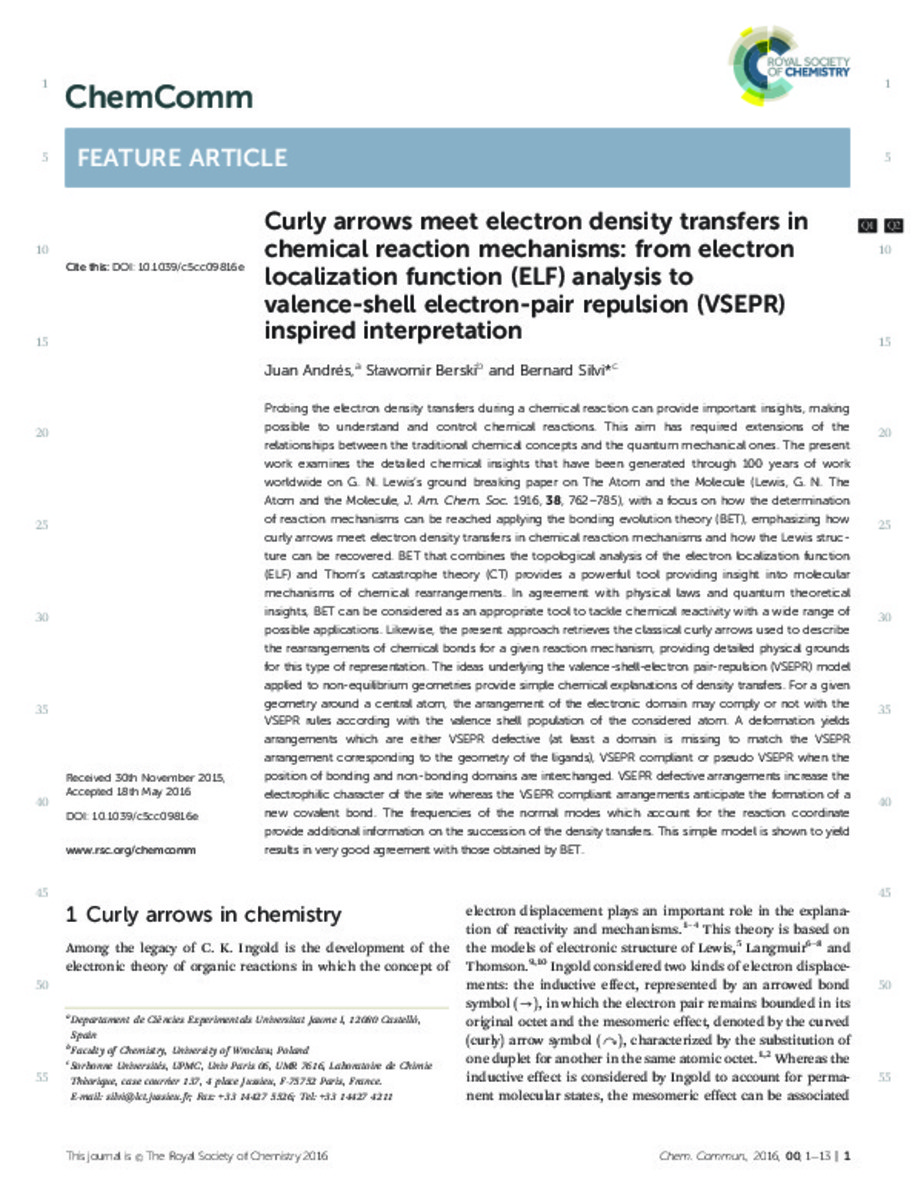Mostrar el registro sencillo del ítem
Curly arrows meet electron density transfers in chemical reaction mechanisms: from electron localization function (ELF) analysis to valence-shell electron-pair repulsion (VSEPR) inspired interpretation
| dc.contributor.author | Andres, Juan | |
| dc.contributor.author | Berski, Slawomir | |
| dc.contributor.author | Silvi, Bernard | |
| dc.date.accessioned | 2016-07-04T07:33:32Z | |
| dc.date.available | 2016-07-04T07:33:32Z | |
| dc.date.issued | 2016 | |
| dc.identifier.citation | ANDRÉS, Juan; BERSKI, Sławomir; SILVI, Bernard. Curly arrows meet electron density transfers in chemical reaction mechanisms: from electron localization function (ELF) analysis to valence-shell electron-pair repulsion (VSEPR) inspired interpretation. Chemical Communications, 2016, vol. 52, no 3, p. 8183-8195. | ca_CA |
| dc.identifier.issn | 1359-7345 | |
| dc.identifier.issn | 1364-548X | |
| dc.identifier.uri | http://hdl.handle.net/10234/161398 | |
| dc.description.abstract | Probing the electron density transfers during a chemical reaction can provide important insights, making possible to understand and control chemical reactions. This aim has required extensions of the relationships between the traditional chemical concepts and the quantum mechanical ones. The present work examines the detailed chemical insights that have been generated through 100 years of work worldwide on G. N. Lewis's ground breaking paper on The Atom and the Molecule (Lewis, G. N. The Atom and the Molecule, J. Am. Chem. Soc. 1916, 38, 762–785), with a focus on how the determination of reaction mechanisms can be reached applying the bonding evolution theory (BET), emphasizing how curly arrows meet electron density transfers in chemical reaction mechanisms and how the Lewis structure can be recovered. BET that combines the topological analysis of the electron localization function (ELF) and Thom's catastrophe theory (CT) provides a powerful tool providing insight into molecular mechanisms of chemical rearrangements. In agreement with physical laws and quantum theoretical insights, BET can be considered as an appropriate tool to tackle chemical reactivity with a wide range of possible applications. Likewise, the present approach retrieves the classical curly arrows used to describe the rearrangements of chemical bonds for a given reaction mechanism, providing detailed physical grounds for this type of representation. The ideas underlying the valence-shell-electron pair-repulsion (VSEPR) model applied to non-equilibrium geometries provide simple chemical explanations of density transfers. For a given geometry around a central atom, the arrangement of the electronic domain may comply or not with the VSEPR rules according with the valence shell population of the considered atom. A deformation yields arrangements which are either VSEPR defective (at least a domain is missing to match the VSEPR arrangement corresponding to the geometry of the ligands), VSEPR compliant or pseudo VSEPR when the position of bonding and non-bonding domains are interchanged. VSEPR defective arrangements increase the electrophilic character of the site whereas the VSEPR compliant arrangements anticipate the formation of a new covalent bond. The frequencies of the normal modes which account for the reaction coordinate provide additional information on the succession of the density transfers. This simple model is shown to yield results in very good agreement with those obtained by BET. | ca_CA |
| dc.description.sponsorShip | We wish to thank Professors R. J. Gillespie, Henry H. Rzepa and Patrick Chaquin and L. R. Domingo for stimulating discussions and the referees for their very constructive comments | ca_CA |
| dc.format.extent | 13 p. | ca_CA |
| dc.format.mimetype | application/pdf | ca_CA |
| dc.language.iso | eng | ca_CA |
| dc.publisher | Royal Society of Chemistry | ca_CA |
| dc.relation.isPartOf | Chemical Communications, 2016, vol. 52, no 3 | ca_CA |
| dc.rights | © Royal Society of Chemistry | ca_CA |
| dc.rights.uri | http://rightsstatements.org/vocab/InC/1.0/ | * |
| dc.subject | curly arrows | ca_CA |
| dc.subject | chemical reactions | ca_CA |
| dc.subject | catastrophe theory | ca_CA |
| dc.subject | electron localization function | ca_CA |
| dc.subject | electron density transfers | ca_CA |
| dc.title | Curly arrows meet electron density transfers in chemical reaction mechanisms: from electron localization function (ELF) analysis to valence-shell electron-pair repulsion (VSEPR) inspired interpretation | ca_CA |
| dc.type | info:eu-repo/semantics/article | ca_CA |
| dc.identifier.doi | http://dx.doi.org/10.1039/C5CC09816E | |
| dc.rights.accessRights | info:eu-repo/semantics/openAccess | ca_CA |
| dc.relation.publisherVersion | http://pubs.rsc.org/en/Content/ArticleLanding/2016/CC/C5CC09816E#!divAbstract | ca_CA |
| dc.type.version | info:eu-repo/semantics/publishedVersion | ca_CA |
Ficheros en el ítem
Este ítem aparece en la(s) siguiente(s) colección(ones)
-
QFA_Articles [813]
Articles de publicacions periòdiques








